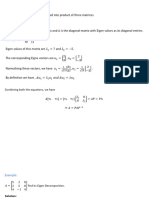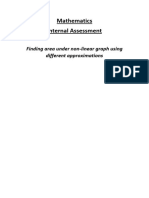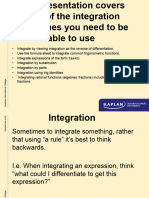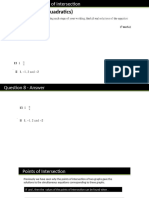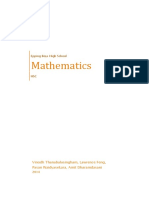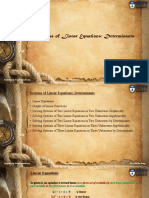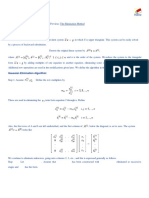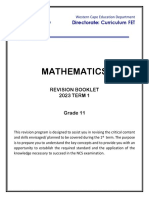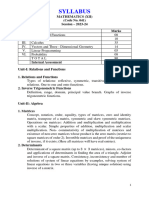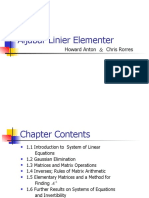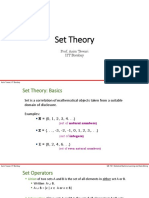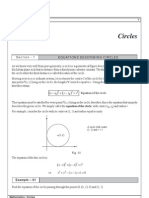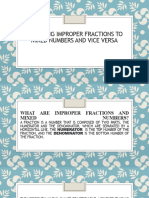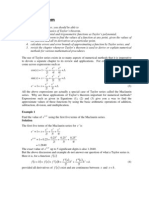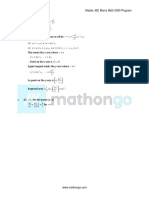LA-W2lineer Alg
LA-W2lineer Alg
Uploaded by
kaan karaaliCopyright:
Available Formats
LA-W2lineer Alg
LA-W2lineer Alg
Uploaded by
kaan karaaliOriginal Title
Copyright
Available Formats
Share this document
Did you find this document useful?
Is this content inappropriate?
Copyright:
Available Formats
LA-W2lineer Alg
LA-W2lineer Alg
Uploaded by
kaan karaaliCopyright:
Available Formats
Linear Algebra and Applications
EEF281E
Week #2
Linear Algebra and Applications 1
1 Midterm, 1 Final Exam
Evaluation : 0.4*Midterm+0.6*Final (UPDATED)
Condition to attend
the Final Exam: Attending the Midterm & 30 pts Average
Linear Algebra and Applications 2
Matrices Vectors are column matrices.
Matrices are series of numbers with defined
orders.
𝑎11 𝑎12 … 𝑎1𝑛
𝑎21 𝑎22 … 𝑎2𝑛
𝐴= ⋮ ⋱ ⋱ ⋮
𝑎𝑚1 … … 𝑎𝑚𝑛 𝑚×𝑛
𝑚 → 𝑛𝑢𝑚𝑏𝑒𝑟 𝑜𝑓 𝑟𝑜𝑤𝑠
𝑛 → 𝑛𝑢𝑚𝑏𝑒𝑟 𝑜𝑓 𝑐𝑜𝑙𝑢𝑚𝑛𝑠
If 𝑚 = 𝑛, this is a square matrix.
Note: Two Matrices can be multiplied
if the number of columns of the first is
equal to the number of rows of the second.
𝐴𝑚×𝑛 𝐵𝑛×𝑝 = 𝐶𝑚×𝑝
Linear Algebra and Applications 3
For instance,
𝐴 𝒙 𝒃
2𝑥1 + 5𝑥2 = 𝑏1 2 5 ฑ
𝑥1 ฐ
𝑏1
=
3𝑥1 + 7𝑥2 = 𝑏2 3 7 𝑥2 𝑏2
In general the way to find 𝒙 is to multiply both
sides of the linear equation by 𝐴−1 .
𝐴−1 𝐴𝒙 = 𝐴−1 𝑏,
𝐴−1 𝐴 =𝟙, 𝟙: Identity matrix
Linear Equations: 1 0 0 An identity matrix is a square matrix
𝐴𝒙 = 𝒃 𝟙= 0 ⋱ 0 having 1s on the main diagonal, and
Now 𝐴 and 𝒃 are known. 0 0 1 𝑛×𝑛
0’s everywhere else.
The task is know to find 𝒙.
Linear Algebra and Applications 4
Yet, we don’t know how to take the inverse of a
matrix, let’s deal with an easy example that we can
estimate the inverse matrix.
Revisit the previous
𝑏1 𝑏1
Example :
𝐴−1 𝑏2 = 𝑏1 + 𝑏2
𝑏3 𝑏1 + 𝑏2 + 𝑏3
We can easily infer that
100
−1
Here, 𝐴 is a difference matrix. 𝐴 = 110
As you see when 𝐴 is applied to a vector 111
Entries of 𝒃 is the differences between the row Apply 𝐴 and 𝐴−1 to different vectors. We see that the inverse of
entries of the previous vector 𝒙. difference matrix is the sum
matrix and vice versa.
Now, let’s solve 𝒙.
This result is similar to the
fundamental theorem of calculus;
integration is the inverse of
differentiation.
Linear Algebra and Applications 5
Note: Now consider,
No combinations of 𝑢, 𝑣, 𝑤 gives 𝑏 = 𝟎.
Here, note that 𝐶𝒙 = 𝟎 solution is possible for infinitely many 𝒙.
𝑢, 𝑣, 𝑤 don’t lie on the same plane. 𝑥1 𝑐 𝑥1 − 𝑥3 0
Therefore, 𝑢, 𝑣, 𝑤 are independent and 𝐴 For, 𝑥2 = 𝑐 , always 𝑥2− 𝑥1 = 0
is invertible. 𝑥3 𝑐 𝑥3 − 𝑥2 0
Therefore, 𝑢, 𝑣, 𝑤 ∗ are linear combinations of each other.
(The only solution for 𝐴𝒙 = 0 is They are dependent vectors.
𝑥1 = 𝑥2 = 𝑥3 = 0. ) They all lie in the same plane.
Matrix 𝐶 is not invertible. 𝐶 is called a singular matrix.
Linear Algebra and Applications 6
Column picture recognize the linear system as a vector equation.
The first vector should be multiplied by 𝑥 = 3 and then
added by the other vector multiplied by 𝑦 = 1.
We introduce new terms;
Row picture, Column picture, Matrix equation
Row Picture shows two lines meeting at a single point.
Linear Algebra and Applications 7
Matrix equation: Construct the coefficient matrix the elimination steps we obtain a triangular form.
Back substitution
𝑦=1
We find 𝑦 = 1 by the second equation and put it into the first.
We call this as back substitution. Solution : 𝑥, 𝑦 = (3,1)
The Idea of Elimination : Here we introduce new terms:
Pivot : First non-zero coefficient in the row
Multiplier (𝑙) : Entry to eliminate divided by pivot
Idea: Subtract a multiple of equation1 from equation2
3 → 𝑠𝑒𝑐𝑜𝑛𝑑 𝑝𝑖𝑣𝑜𝑡
and produce an upper triangular system. 𝑙=
1 → 𝑓𝑖𝑟𝑠𝑡 𝑝𝑖𝑣𝑜𝑡
Example:
Multiply Eq.1 by 𝑙 = 3
and subtract from Eq.2
Linear Algebra and Applications 8
Example:
4𝑥 − 8𝑦 = 4
3𝑥 + 2𝑦 = 11
Back substitution
𝑦=1
The new equation in the triangular form
starts with the second pivot which is 8.
If there were the third equation, we would
use it to eliminate 𝑦 from the third.
Temporary failure
Failure of elimination:
Elimination does not work with singular
equations.
This eq. has no solution. There is no second pivot.
Zero pivot is not allowed.
Linear Algebra and Applications 9
Three equations in three
unknowns First multiplier Now, we have
1
(1) 2𝑥 + 4𝑦 − 2𝑧 = 2 New multiplier : 𝑙3′ 2′ = = 1
1
(2′ ) 𝑦+𝑧 = 4
′
(3 ) 𝑦 + 5𝑧 = 12
Step3: Subtract equation (2′ ) from (3′ )
Step1: Subtract 2 times equation (1) Then,
from equation (2) 4𝑧 = 8
Finally,
We have 𝑦=2
𝑦+𝑧 =4
𝑧=2
Now let’s find the second multiplier:
Solution : 𝑥, 𝑦, 𝑧 = (−1,2,2)
Step2: Subtract -1 times equation (1)
from equation (3). Therefore, the original 𝐴𝒙 = 𝒃
has been converted into upper triangular 𝑈𝒙 = 𝒄
We have
𝑦 + 5𝑧 = 12
Linear Algebra and Applications 10
You might also like
- Summary Notes For Pure Maths P1 9709 - 1Document24 pagesSummary Notes For Pure Maths P1 9709 - 1Nat Gari67% (3)
- Math1070 130notes PDFDocument6 pagesMath1070 130notes PDFPrasad KharatNo ratings yet
- Eigen DecompositionDocument24 pagesEigen DecompositionpatricknamdevNo ratings yet
- AGEC516 - L9-10 - Matrix Algebra IDocument28 pagesAGEC516 - L9-10 - Matrix Algebra Ialonso estevezNo ratings yet
- Igcsemath9a1ch9matricestransformations NotesDocument11 pagesIgcsemath9a1ch9matricestransformations NotesteacheryinyineduNo ratings yet
- ChBE6500 HW3Document5 pagesChBE6500 HW3AnnNo ratings yet
- Integration Estimations HL MATH IA SampleDocument18 pagesIntegration Estimations HL MATH IA SampleCoffee MugNo ratings yet
- 2C - Matrix InversesDocument6 pages2C - Matrix InversesNIDHINo ratings yet
- MODULE1Document29 pagesMODULE1Sanju MalikNo ratings yet
- AlgebraDocument61 pagesAlgebrapiranginandhinicharyNo ratings yet
- Differential Equations and Linear Algebra Supplementary NotesDocument17 pagesDifferential Equations and Linear Algebra Supplementary NotesOyster MacNo ratings yet
- The Idea of IntegralDocument11 pagesThe Idea of IntegralYumie YamazukiNo ratings yet
- Module 1 Theory of MatricesDocument75 pagesModule 1 Theory of MatricesShashank MahaleNo ratings yet
- LA-W1lineer AlgDocument22 pagesLA-W1lineer Algkaan karaaliNo ratings yet
- Functions Revision BookletDocument58 pagesFunctions Revision Bookletm07shele2No ratings yet
- 1 Basic Geometric Intuition: For Example, See Theorems 6.3.8 and 6.3.9 in Lay's Linear Algebra Book On The SyllabusDocument3 pages1 Basic Geometric Intuition: For Example, See Theorems 6.3.8 and 6.3.9 in Lay's Linear Algebra Book On The SyllabusKadirNo ratings yet
- Lecture 01Document40 pagesLecture 01What’up BitchNo ratings yet
- CVE 154 Lesson 1 Introduction To Numerical SolutionsDocument28 pagesCVE 154 Lesson 1 Introduction To Numerical SolutionsIce BoxNo ratings yet
- Ijmtt V65i3p504Document8 pagesIjmtt V65i3p504A M CNo ratings yet
- MT1004 F24 LA Homework 36 Positive Definite MatricesDocument4 pagesMT1004 F24 LA Homework 36 Positive Definite Matricesi232092No ratings yet
- Lecturer1 Optimization TechniqueDocument30 pagesLecturer1 Optimization Techniqueitsirs000No ratings yet
- Week 6 - Module 5 Karnaugh MapsDocument10 pagesWeek 6 - Module 5 Karnaugh MapsBen GwenNo ratings yet
- Diff. Calc. Module 7 Trigonometric & Inverse FunctionsDocument10 pagesDiff. Calc. Module 7 Trigonometric & Inverse FunctionsFernandez DanielNo ratings yet
- W5 Lesson 3 - Systems of Linear Equations (Part 2) - ModuleDocument8 pagesW5 Lesson 3 - Systems of Linear Equations (Part 2) - ModuleMelanie BuñalesNo ratings yet
- 04 Systems of EquationsDocument18 pages04 Systems of EquationsYeri KimNo ratings yet
- 7-Mathematics Foundations SLMDocument100 pages7-Mathematics Foundations SLMva.vitekaramitNo ratings yet
- Extra Help 19 - Further IntegrationDocument56 pagesExtra Help 19 - Further Integrationqiubao6767No ratings yet
- Linear Relations and Equations pp8Document64 pagesLinear Relations and Equations pp8Gehan FaroukNo ratings yet
- Fungat LectureDocument5 pagesFungat Lectureabdullahtahir1pkNo ratings yet
- Linear SystemsDocument2 pagesLinear SystemsYoni MarindaNo ratings yet
- Lesson 3Document13 pagesLesson 3CHICKENLORDMEZNo ratings yet
- 2U MathsDocument122 pages2U MathsRickyNo ratings yet
- Matrices Full Lecture NoteDocument66 pagesMatrices Full Lecture Notepuvi ththiraNo ratings yet
- Algebra For College Students 7ed (2013) Chapter 2Document88 pagesAlgebra For College Students 7ed (2013) Chapter 2Reign ManeseNo ratings yet
- Ilovepdf MergedDocument90 pagesIlovepdf MergedAhmed SallamNo ratings yet
- 1ZC3_Final_Lectures_Summary (2)Document8 pages1ZC3_Final_Lectures_Summary (2)xujamin90No ratings yet
- Functions Last PushDocument56 pagesFunctions Last Pushgamerax22No ratings yet
- Systems of Linear Equations. - Part IDocument9 pagesSystems of Linear Equations. - Part IYE KONo ratings yet
- Gaussian EliminationDocument22 pagesGaussian Eliminationnefoxy100% (1)
- (Lec 1)Document5 pages(Lec 1)lujainakram2004lujain12356No ratings yet
- Chapter 2 M 1Document34 pagesChapter 2 M 1Isra WaheedNo ratings yet
- ES 11 Formula Sheet v1Document3 pagesES 11 Formula Sheet v1Sam RuelosNo ratings yet
- Non LinearDocument18 pagesNon Linearmhao49480No ratings yet
- My Revision Notes (Entire Unit) c4 Edexcel NotesDocument15 pagesMy Revision Notes (Entire Unit) c4 Edexcel Notesjun29No ratings yet
- Differential CalculusDocument93 pagesDifferential Calculusdavidkekana217No ratings yet
- Chapter 6Document5 pagesChapter 6Muntazir MehdiNo ratings yet
- Inverse of A Matrix: CHAPT E R 1 Systems of Linear Equations and MatricesDocument8 pagesInverse of A Matrix: CHAPT E R 1 Systems of Linear Equations and MatricesPhạm Lê Tuyết NhungNo ratings yet
- Introduction, Linear EquationDocument8 pagesIntroduction, Linear Equationanasbro009No ratings yet
- System of Linear Equation and ApplicationDocument32 pagesSystem of Linear Equation and Applicationihsaanbava0% (1)
- Barnett Calc Ch01Document45 pagesBarnett Calc Ch01niharika pandeyNo ratings yet
- Image Compression Using Singular Value Decomposition (SVD)Document23 pagesImage Compression Using Singular Value Decomposition (SVD)M Chandan ShankarNo ratings yet
- Algebra Reference: Basic IdentitiesDocument18 pagesAlgebra Reference: Basic IdentitiesgowsikhNo ratings yet
- Calulus 11Document25 pagesCalulus 11jeph labradorNo ratings yet
- Mathematics Grade 11 Revision Term 1 - 2023Document16 pagesMathematics Grade 11 Revision Term 1 - 2023ora mashaNo ratings yet
- Functions Last PushDocument56 pagesFunctions Last Pushvanessamahlatse81No ratings yet
- QA Basic Calculus Quarter 3 Week 6 FinalDocument7 pagesQA Basic Calculus Quarter 3 Week 6 Finalelyzaventura8No ratings yet
- BSI-111 Linear Algebra: Dr. Abid IqbalDocument30 pagesBSI-111 Linear Algebra: Dr. Abid IqbalHannan Sajjad JZ Batch 22No ratings yet
- Class Xii Mathematics BookletDocument239 pagesClass Xii Mathematics BookletBasant KothariNo ratings yet
- 第二章Document61 pages第二章yanshanzhou353No ratings yet
- A-level Maths Revision: Cheeky Revision ShortcutsFrom EverandA-level Maths Revision: Cheeky Revision ShortcutsRating: 3.5 out of 5 stars3.5/5 (8)
- LA-W1lineer AlgDocument22 pagesLA-W1lineer Algkaan karaaliNo ratings yet
- LA-W4lineer AlgDocument10 pagesLA-W4lineer Algkaan karaaliNo ratings yet
- LA-W7lineer AlgDocument15 pagesLA-W7lineer Algkaan karaaliNo ratings yet
- LA-W5lineer AlgDocument11 pagesLA-W5lineer Algkaan karaaliNo ratings yet
- LA-W6 Lineer AlgDocument11 pagesLA-W6 Lineer Algkaan karaaliNo ratings yet
- Applied EconometricsDocument74 pagesApplied EconometricsHenry Pham100% (1)
- CH 6 MCQDocument21 pagesCH 6 MCQANIKET ROYNo ratings yet
- Springfield Convent Senior School September Examinations 2017 Grade 12 Mathematics Paper 1Document7 pagesSpringfield Convent Senior School September Examinations 2017 Grade 12 Mathematics Paper 1Chey1242No ratings yet
- MIT18 102s21 Lec3Document5 pagesMIT18 102s21 Lec3vladimirNo ratings yet
- Aljabar Linier Elementer: Howard Anton Chris RorresDocument78 pagesAljabar Linier Elementer: Howard Anton Chris RorresLukmanulhakim AlmamalikNo ratings yet
- Set Theory: Prof. Asim Tewari IIT BombayDocument22 pagesSet Theory: Prof. Asim Tewari IIT BombayScion Of VirikvasNo ratings yet
- CirclesDocument81 pagesCirclesHassan Kumar GunduNo ratings yet
- Vector 3d MathongoDocument13 pagesVector 3d MathongoArya NairNo ratings yet
- The NIMO Compendium: Evan ChenDocument67 pagesThe NIMO Compendium: Evan ChenAGNIBESH BHANJANo ratings yet
- Maths Refresher Workbook 1Document42 pagesMaths Refresher Workbook 1KBNo ratings yet
- Applied Partial Differential Equations With Fourier Series and Boundary Value ProblemsDocument784 pagesApplied Partial Differential Equations With Fourier Series and Boundary Value ProblemsJeanne JacksonNo ratings yet
- Kontrak Bilangan Latihan Matematik THN 3Document2 pagesKontrak Bilangan Latihan Matematik THN 3Zariah Abd SamadNo ratings yet
- 1.10.3. The Deformation Tensor.: U U X U XDocument2 pages1.10.3. The Deformation Tensor.: U U X U XVinay Chandwani100% (1)
- Faculty of Sciences Mathematics: Math 200, Calculus IDocument5 pagesFaculty of Sciences Mathematics: Math 200, Calculus Ilaura sageNo ratings yet
- Changing Improper Fractions To Mixed Numbers and ViceDocument11 pagesChanging Improper Fractions To Mixed Numbers and ViceRubymae OrejudosNo ratings yet
- Chapter 9 - The Power of Calculus PDFDocument24 pagesChapter 9 - The Power of Calculus PDFKaran ShahNo ratings yet
- Revision TestDocument11 pagesRevision Testhunia abbassNo ratings yet
- Concept Map CalDocument5 pagesConcept Map CalRahila DeeNo ratings yet
- MLPR w0d - Machine Learning and Pattern RecognitionDocument3 pagesMLPR w0d - Machine Learning and Pattern RecognitionzeliawillscumbergNo ratings yet
- Lecture 5 Integrating Factor Found by Inspection IFFIDocument6 pagesLecture 5 Integrating Factor Found by Inspection IFFIRaquel PanillosNo ratings yet
- Lecture 2 Numeric Solution of Differential EquationsDocument45 pagesLecture 2 Numeric Solution of Differential EquationsManuelNo ratings yet
- Taylor SeriesDocument7 pagesTaylor SeriesSaima NasirNo ratings yet
- Question 1166669Document3 pagesQuestion 1166669jhashubh015No ratings yet
- AOD Sheet 1 Mathongo SolutionsDocument8 pagesAOD Sheet 1 Mathongo SolutionsPranav Singh RajputNo ratings yet
- Diamond GraphDocument3 pagesDiamond GraphdoraxNo ratings yet
- Eig (MATLAB Functions)Document4 pagesEig (MATLAB Functions)Akash RamannNo ratings yet
- Degree / Branch:: Page No: 1/2Document2 pagesDegree / Branch:: Page No: 1/2vinithaNo ratings yet
- Btech 2 Sem Engineering Mathematics 2 Kas203t 2022 1Document2 pagesBtech 2 Sem Engineering Mathematics 2 Kas203t 2022 1mishikabhandarisNo ratings yet


